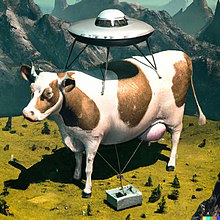
Back فن الذكاء الاصطناعي Arabic Art d'intel·ligència artificial Catalan KI-Kunst German Bildarta kapablo de artefarita intelekto Esperanto Arte de inteligencia artificial Spanish اثر هنری با هوش مصنوعی Persian Tekoälytaide Finnish Art créé par intelligence artificielle French Ellyn ar-inçhynagh GV אומנות בינה מלאכותית HE

1960's art of cow getting abducted by UFO in midwestArtificial intelligence art is visual artwork created or enhanced through the use of artificial intelligence (AI) programs.
Artists began to create artificial intelligence art in the mid to late 20th century when the discipline was founded. Throughout its history, artificial intelligence art has raised many philosophical concerns related to the human mind, artificial beings, and what can be considered art in a human–AI collaboration. Since the 20th century, artists have used AI to create art, some of which has been exhibited in museums and won awards.[1]
During the AI boom of the early 2020s, text-to-image models such as Midjourney, DALL-E, Stable Diffusion, and FLUX.1 became widely available to the public, allowing non-artists to quickly generate imagery with little effort.[2][3] Commentary about AI art in the 2020s has often focused on issues related to copyright, deception, defamation, and its impact on more traditional artists, including technological unemployment. Opinions have also risen on the possible effect AI generated art might have on creativity.
- ^ Todorovic, Milos (2024). "AI and Heritage: A Discussion on Rethinking Heritage in a Digital World". International Journal of Cultural and Social Studies. 10 (1): 1–11. doi:10.46442/intjcss.1397403. Retrieved 4 July 2024.
- ^ Vincent, James (24 May 2022). "All these images were generated with Google's latest text-to-image AI". The Verge. Vox Media. Retrieved 28 May 2022.
- ^ Edwards, Benj (2 August 2024). "FLUX: This new AI image generator is eerily good at creating human hands". Ars Technica. Retrieved 17 November 2024.